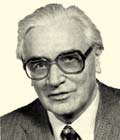
Zuse, Konrad (1910-1995)
German Inventor of the binary computer, Zuse designed and implemented the principles of modern computers, initially without knowledge of Babbage’s work and other works related to the development of computers.
He was born on 22 June 1910 in Berlin-Wilmersdorf (Germany) and grew up in the East Prussian town of Brausber, where he attended the Humanistisches Gymnasium.
In 1927 he commenced his civil engineering studies at the Technische Hochschule in Berlin which he completed in 1935. While studying for his degree, he started to work at the Henschel aircraft company, where he studied the tensions caused by vibrations on aircraftwings.
In 1934, he started to build his Z1 machine in the hall of his parents’ house. He completed the machine in 1938. He was motivated to build this machine by his need for a device for making calculations for his engineering studies and work. Its design and implementation using fully mechanical switches led to the construction of the first digital computer in the world.
Around 1938, he began building his prototype machine, Z2, in which he replaced the mechanical part devised to make calculations by 200 electromechanical relays, leaving the Z1’s mechanical memory (16 bits) and the punch card reader unchanged. This system was capable of working in 16-bit fixed-point arithmetic.
His experience with the Z2 and the full redesign of his Z1 model for electromechanical relays resulted in his Z3 machine, which was finished in 1941. This last model can be considered as the first fully operational computer in the world. It was able to add, subtract, multiply, divide and calculate square roots. It worked in binary with floating-point arithmetic. It operated with 22-bit word lengths and required 2,400 relays, 600 for the calculations and programs sections and 1,800 for the memory section.
The Z1, Z2 and Z3 computers were destroyed in 1944 towards the end of World War II, but the Z1 and Z3 models were reproduced due to their historical importance. A reproduction of Z1 has been exhibited in Berlin’s Deutsches Technikmuseum since 1989 and a replica of the Z3 has been on display at the Deutsches Museum in Munich since 1960.
He founded his own company, the Berlin-based Zuse-Ingenieur-Büro, and began to work on the Z4 model in 1942. When the machine was almost fully implemented, it was moved to the Aerodynamische Versuchsanstalt in Göttingen to keep it safe from air raids, but it had to be moved again only a few weeks later to the small town of Hinterstein in Bavaria due to the advance of the Russian troops. The Z4 was finally installed in the Swiss Federal Institute of Technology (ETH) in Zurich in 1950, where it remained in operation until 1955.
In addition to his Z-series designs, he built the S1 and S2 machines designed to solve problems related to aircraft design, and the L1 aimed at solving not only calculus but also logical problems. The L1 was no more than a prototype.
In 1945, he developed his first programming language, called Plankalkül, which he used to design a program that played chess. Although this language was not widely used, it laid the groundwork for the development of the ALGOL language.
Around 1958, he completed his design for a transistor-based machine, the Z22 model.
Throughout his lifetime, he received distinctions and prizes from several prestigious international institutions for his work.
Zuse continued to research and develop computers as a consultant for Siemens from when it absorbed his company until 1967.
Zuse died on 18 December 1995 in Hünfeld (Germany).
